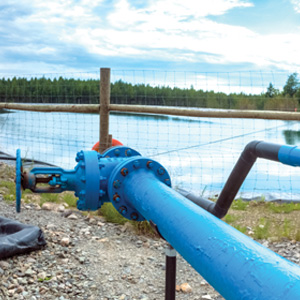In the 1950s, I was involved in oil drilling gas in southeastern Kansas. Much of the free-flowing, 28 gravity (thick) oil had diminished to one to three barrels per day. Hence came secondary recovery!
One method of secondary recovery was the injection of high-pressure saltwater into the oil sands to force the oil and gas to the surface.
Another was CO2 injection. This was an attempt to force carbonated water into the sands to force the oil and gas to the production wells. These wells were drilled in a five spot. Four wells were injection wells while the fifth well in the center was the production well.

|
|
A containment pond holds water produced by fracking a Marcellus Shale gas well. Porky says more research by qualified groundwater experts could get to the bottom of the fracking controversy. Source: iStock |
Electrofrac was another experiment. They drilled on a five spot, meaning four electrodes on the outer perimeter and a grounding well in the middle. These were to be connected to a power line or generator through a transformer that would convert the high voltage to low voltage. The idea was to heat the heavy gravity oil in the ground, making it flow better by making the oil thinner. We sold our company, Cutter & Dad Drilling Company, during this time, moved out of the area and didn’t follow this method further. In 2009, I understand Exxon was attempting a similar method in another area of the United States.
Most of these wells were about 850 feet in depth. We fracked many of these wells with saltwater and occasionally with crude oil. Fracturing by this method would sometimes increase the flow tenfold. Years later, when we returned for a visit, they were doing what they called high-speed fracturing. We were advised that this method sometimes increased the flow 50-fold. To my knowledge, none of these fracturing methods has ever damaged the groundwaters or streams.
Now comes horizontal drilling and a new technology of perforating the casing and hydrofracking with special chemicals to thicken the fracturing fluids, one of them being guar gum. Today, guar gums are preferred as thickeners for Enhanced Oil Recovery (EOR). Guar gum and its derivatives account for most of the gelled fracturing fluids.
My first thought was that fracturing horizontal oil or gas well at the depths they are fracturing would be no different than fracturing a deep vertical well, but my thinking has changed due to a few water wells and streams becoming contaminated with oil and gas in the areas of oil/gas wells in Pennsylvania and other areas of the U.S.
More research and onsite observation need to be made by qualified groundwater experts. Most of the research has been done by unqualified groundwater experts, who then hired attorneys to sell judges on the ideas that fracturing does no damage to ground and surface waters, even though many homeowners can ignite the waters coming from their faucets.
I understand that a few companies have made financial settlements with some homeowners that have been affected. However, the settlement agreements have disallowed those people from discussing their problems further.
In the near future, I believe that research and proper testing will prove that horizontal fracturing does and is affecting our ground and surface waters.
In support of oil and gas companies: I have been talking to several farm owners in Oklahoma and they like the royalties they are receiving and, to date, have encountered no problems from the hydrofracturing of directionally drilled oil/gas wells in their areas. Only time will tell!




Report Abusive Comment